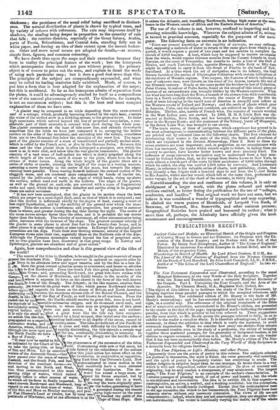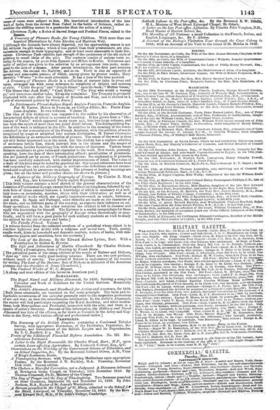PUBLICATIONS RECEIVED'.
Boosts.
Ancient Coins and .11feda1s; an Historical. Sketch of tire Origin and Progress of Coining Money in Greece and her Colonies; its-Progress with the Ek- tension of the Roman Empire ; and its Decline with the Fall of that Power- By Henry Noel Humphreys . Author of "The Coins of England:" Illustrated by numerous Fac-simile Examples in Actual Relief, and in the Metals of the respective Coins. Wanderings in Search of Ilhalth. By Lord Albert- Denison, K.C.H., &I. The Liver of the Chief J7ustices of England; from the. Norman Conquest till the-Death of Lord Mansfield: By John Lord Campbell, LL.D:, F.R.S.E., Author of "The Lives of' the.Lord Chancellors of England." In two vo- lumes.
The New Testament Expounded and Illustrated, according to. the usual Marginal Reference; in the very Words of the Holy Scripture. Together with the Notes and Translations, and a- complete Marginal Harmony of the Gospels. Part L Containing the Four Gospels and the Acts of the Apostles. By Clement Moody, BLA., Magdalen Hall; Osford, &c. [The object of this edition is to facilitate the study-of the New Testaineot, by bringing together those parallel passages to which, the marginal references only direct the reader. The celebrated edition of Dr. Blaney is the basis of Mr. Moody's undertaking ; and he has executed ha, useful task on a judicious prin, ciple, ia a careful way. The references of the original, translators of the Bible and of successive authorities, accumulated in Dr. Blaney's edition, are presented to the reader anthe foot of the page; typographical marks indleatingtheessential parallel, from that which is peculiar to the text referred to. These suggestions are the more useful, as Mr. Moody quotes the passages referred to fully, so as to exhibit to the-reader a. complete-whole. It is- therefore advantageous, if not really necessary,. Indirect the attention a) that which is really the harmony, to avoid erroneous. impressions. When we consider how every one shrinks.from minute and reiterated trouble, even in the study of a profession' the utility, of bringing together these scattered passages, for the generality of Scriptural readers,, is toe obvious to require comment; so obvious ie it, indeed, that one can only wonder that it has not been systematically done before. Mr. Moody's edition of The New Testament Expounded and Illustrated in the Very. Wordr of Holy Scripture in
a desirable book for religious families.]
The Four Pilgrims, or Life's Mission; and other Poems. [Apparently. there are the germs of poetry in this volume. The subjects selected are poetical ni themselves, the style is fluent, the verse generally well-sounding, and. the spirit of poetry is frequently visible: but everything is crude. The author delights in subjects larger than. he can manege; he treats them ia a.way which is wild and rhapsodical, rather than artistica]. He aims at mastery and originality, but he only reaches a strangeness, of easy attainment.. The longest Poem, "The Four Pilgrims," is an example of the author's characteristics.. It. contains passages of pleasing merit, if not of power and beauty ; but thewhole ism:maltreated anclinconclusivs The idea is to exhibit life in four aspects—a contemplative, an active, a wedded, and a working condition: but the conception, though not bad, is insufficiently developed. Except that the contemplative man in old age reconciles the widow to her bereavement, the Four Pilgrims form four separate stories without any necessary connexion. The views of life aremot comprehensive; indeed, where they are not commonplace, they are singular with- out individuality. The writer is continually varying his metre, as if the whole
range of verse were subject to him. His inartistical introduction of the late wars of India from the retreat from Cabal to the battle of Sobraon, rather re- sembles the shifting scenes in a pantomine than the action of a story.]
Christmas Tsde; a Snits of Sacred Songs and Poetical Pieces, suited to the Season.
A Treasury of Pleasure Books for Young Children- With inure than one hundred Illustrations by John Abs.olon and Harrison Weir. Although the Annuals have almost departed, yet the approaching season is not left without its gift-books; which if less garish than their predecessors, are eha- ractesistie enough in their typography, and at least more seasonable in their lite- settees Christmas Tyde exhibits just enough of the quaintness of the old style of printing to recall ideas of the past. The contents consist of serious verse re- lating to the sesserr, by poets from Spenser and Milton to Reeble. Coherence and unity of subject are given to the selection by an arrangement into parts, analo- anuatothe acts of a damn*. After poems introductory, the first part contains the Advent, the second the Nativity, and soon. There is also an appendix of evader and seasonable poems; of which, among pieces by greater names, Mary Rewitt's "Winter" is the most attractive. It has a tone of the true pastoral. A Treasury of Pleasure Books is a collection of nursery tales in prose and verse, arranged too with some reference to simplicity of subject and easiness. of style. "Little Bo-peep" and "Simple Simon" open the book; "Mother Goose," "The- House that Jack Built," "Cock Robin," "The Frog who would- a wooing go,” and numerous similar tales,, fill up the remainder. Tbe Treasury is profusely illustrated with cuts after the designs of Absolon and Weir, and is clothed in a garb of ornamental pattern by Oxen Jones.] Le Dictionnaire Phraseobigique Royal; Anglais-Francais, Francais-Anglais. Par M. Tarver, Maitre de Franc ;is au College d'Etoa, &c. Partie Fran- caise-Anglaise. In two volumes. Volume IL [The idea of this dictionary was suggested to the author by his observation of the practical. defects of others in a course of teaching. It has grown from a "Dic- tionary of Verbs," which appeared many yearn ago, into two large volumes, and has been the result of more than ten years' direct labour. The distinguishing fea- ture of the work is indicated in the title. In additioa to the meaning of the words contained in the nomenclature of the French Academy, with the addition of words recognized by usage or admitted into modern dictionaries, M. Tarver illustrates the by an extensive selection of' phrases. The sense of the word is thus not only better impressed linen the mind, but the student has a copious selection of sentences before him, which instruct him in the idioms and the-usages of conversation, besides furnishing him with the means of discourse. Various lesser fkatures contribute to give value and character to the work. New words, generally speaking, have the date of their-introduction affixed; peculiarities of pronuncia- tion are pointed out by means of French indications; the explanation of proverbs has been carefully considered, with similar improvements of detail. The value of a work of this kind must be tested by poetical use. Our casual references have been well responded to: and one advantage is evident—the definitions are not encum- bered-and confused by numerous meanings. The primary or leading meanings are given; but all the lesser and peculiar shades are shown in phrases.] An Epitome of the Military Geography of Europe. By Charles R. Max:: well, Esq., late Lieutenant Thirty-eighth Regiment, [This little volume contains a brief sketch of the general characteristics of the countries of Continental Europe, except the-Scandinavian kingdoms, followed by mi- nute lists of those.natural features a knowledge of which is necessary to a mili - My man—as mountains, marshes, rivers with their tributaries; as well as of those artificial works which are equally important—such as canals, fortresses, and ports. In. Spain- and Portugal, some remarks are made on the character of the roads, and on different parted the country, as regards their influence on mi- litary operations; but in the other countries the student is left to discover and apply this knowledge for himself. The Epitome is a. useful compendium for those who are acquainted with the geography of Europe either theoretically or prac- tically, and it will form a good. guide for such military students as wish to study the-subject by. the aid of maps and books.] The Family Friend: Volume L [A volume formed from the collected numbers. of a periodical whose object is to combine lightness and utility with a religious and moral tone. Tales, poetry, needle-work, hints in household and domestic matters, notices of books, with mis- cellaneous papers and anecdotes, form the contents.] The Last of the Barons. By Sir Edward Bawer Lytton,. Bart. With a Frontispiece by Hablot K. Browne. . The Life and Adventures of Martin Chuazlewit. By Charles Dickens. With a Frontispiece, from a Drawing by Frank Stone. [The-periodical parts of the cheap editions of the novels of Bulwer and Dickens, " done up" into two really good-looking volumes. There are two new prefaces, without much of novelty. The preface of Bulwer is explanatory of his reasons foewtiring The Last of the Barons; that of Dickens is defensive of his American pictures and the character of Jonas Chuzzleait]
The Poetical Works of W. C. Bryant. [A cheap and neat edition of this favourite American poet.] •
ALMA'V ACKS.
The Royal Naval and Military A lnutnack, for 1850; forming a complete . Calendar and Work of Reference for the United Services. Beautifully Illustrated.
• The Artist's Almanack, and Handbook for Artists and Amateurs for 1850. [Both these almanacks are executed on the same principle. The facts and re- markable occurrences of the calendar generally refer to the respective professions of art and war; as does the miscellaneous information. In the Artist's Ahnahack, the reader will find. particulars respecting the Royal Academy, and other institu- tions, both Metropolitan sod Provincial, connected with the arts; and there is a species of artist's directory. Ihstead of this information, the Military and Naval Ahnanack has lists of the cffieers, as far down as Colonels in the Army and.Cap- tains in the. Navy, with various official and professional tables.] PAMPHLETS.
The Economy of the British Empire; containing a Condensed Tabular Survey, with appropriate Discussion, of the Territories, Population Re- sources,, and Government of the British Empire and its Dependencies. By T. C. Bandeld, Eq. No. L .Tracti of the Edinburgh Financial Reform Association. No. III. Mis- - eellaneous Estimates. '
A Letter to the Right Honourable Sir Charles Wood, Bart, M.P., upon
. certain Laws affecting Agriculture. By. Frederick Calvert, Esq., Q.C. Observations on the Working of the Government Scheme of Education, and on School Inspection, &c. By the Reverend Richard Dawes, A.M., Vicar of King's.Sombornei Hants. A Thanksgiving Serrnon; with Thanksgiving Meditations upon appropriate
• Psalms. By the Reverend J. W. Buckley, M.A. Thursday, November 15th 1840. Second edition.
• The Cholera- a Merciful Correction, not a Judgment. A Discourse delivered at Newington Green Chapel, on Thursday, 11th November 1849. By Thomas-Cromwell, Ph.D., Minister-of the Chapel. The Day of Prayer and the Day of Thanksgiving. Two Sermonspreached
on thcao Occasions September. 16 and November 15, 1819. By John
Sabbath Labour in the Post-office, &a. By the Reverend R. W. Dtbdk M.A., Minister of West Street Episcopal Chapel, St. Giles's. A Letter on the late Post-office Agitation- By Charles John Vaughan, D.D., Head Master of Harrow School, &e. The Morality of All Nations; a small Collection in the French, Italian, and English Languages, &c. By F. Albite& A Journal of the Bishop's Visitation Tour through the Cape Colony in 1848; with an Account of his Visit to the island of St. Helena in 1849-



























 Previous page
Previous page